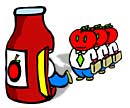|
Ketchup is as ketchup does – The Dorfman Archives
Ketchup is one of those things that always seems to be there, but we never really think about. Every time we order a hamburger, hot dog, meatloaf or scrambled eggs, we pour and slather, slather and pour, and don’t give it a single thought. Although popular all year round, in summer its sales soar as backyard grills heat up. Historically, ketchup is America’s most widely used condiment and is found in 97% of all kitchens. This showing is only matched by salt, pepper, sugar and salsa, although not the dance floor variety.

Some researchers claim that the way a person pours his or her ketchup reveals many secrets about their personality. From dippers and squirters, to sprinklers and smotherers, psychologist, Donna Dawson has identified seven "sauciological" types. Those who dunk into a well of ketchup are methodical and trustworthy. Secretly, they may also lead double lives as control freaks or spies who are afraid of change. Ambitious people splodge their sauce in the middle of their food. (This may indicate that they are middle of the road politically as well, but it’s not a sure-fire test.) Creative types swirl and squirt in thin lines. Those who dot their ketchup are friendly, but highly conservative in life style. Smotherers are the life and soul of the party, but keep them away from people sleeping on high pillows. Those with artistic ability may draw faces and words on their food. Gourmets who keep their ketchup in a cruet may appear charming, but deep down they are snobs and harbor animosities towards ordinary bottles!
Where did this wonderful condiment come from? As American as it seems, its origins lie within the Indonesian and Asian cultures. The spicy, pickled fish sauce made of anchovies, walnuts, mushrooms and kidney beans was called ke-tsiap and was very popular in 17th century China. It had a savory taste, flavored by the brine spices and fish. Its texture was more like a soy or Worchestshire sauce. British seamen brought ke-tsiap home, changed the name to catchup and then to catsup. Ketchup was first mentioned in print around 1690. Colonial Americans borrowed and tinkered with the English recipes for catsup and were the first to add tomatoes to the blend after experimenting with tarter vegetables, spices, mushrooms and walnuts.
 Henry J. Heinz began making ketchup in 1876. His recipe remains the same to this day. It became so popular that other manufacturers rushed to catch up to the ketchup craze. (Catchup to catsup might have been the slogan of the day.) Soon Ketchup, Catsup, Catchup, Ketsup, Catsip, Cotsup, Kotchup, Kitsip, Catsoup, Katshoup, Katsock, cackchop, Cornchop, Cotpock, Kotpock, Kutpuck, Kutchpack and Catchpuck were all available for sale. All were tomato-based and vied to become a household word (or at least a confusing option among many others). Only three major brands survived: Heinz Ketchup, DelMonte Catsup and Hunt’s, who could not make up their mind and bottled under the names Hunt’s Catsup (east of the Mississippi), Hunt’s Ketchup (west of that same river) and Hunt’s Cornchops in Iowa only. Henry J. Heinz began making ketchup in 1876. His recipe remains the same to this day. It became so popular that other manufacturers rushed to catch up to the ketchup craze. (Catchup to catsup might have been the slogan of the day.) Soon Ketchup, Catsup, Catchup, Ketsup, Catsip, Cotsup, Kotchup, Kitsip, Catsoup, Katshoup, Katsock, cackchop, Cornchop, Cotpock, Kotpock, Kutpuck, Kutchpack and Catchpuck were all available for sale. All were tomato-based and vied to become a household word (or at least a confusing option among many others). Only three major brands survived: Heinz Ketchup, DelMonte Catsup and Hunt’s, who could not make up their mind and bottled under the names Hunt’s Catsup (east of the Mississippi), Hunt’s Ketchup (west of that same river) and Hunt’s Cornchops in Iowa only.
 When H.J. Heinz began advertising the health benefits of consuming ketchup, the scientific world responded with a serious campaign which determined that frequent consumption of cooked tomato products is associated with a decreased risk of cancer. Tomatoes contain lycopene, which is a carotenoid that functions as an antioxidant and gives the red color to tomatoes, watermelon and red grapefruit. According to Dr. Lenore Kohlmeir, professor of nutrition and epidemeology at the University of North Carolina, "lycopene is better absorbed from cooked tomato products that contain fat." We recommend that people eat tomato-based cooked foods." Watch out here though. Adding ketchup to hamburgers and using lycopene as an excuse to order that plate of french fries won’t make them health foods. The typical serving size of ketchup does not contain enough lycopene to make a significant difference anyway. (If only that were so with thighs and buttocks after too much fast food!)
When H.J. Heinz began advertising the health benefits of consuming ketchup, the scientific world responded with a serious campaign which determined that frequent consumption of cooked tomato products is associated with a decreased risk of cancer. Tomatoes contain lycopene, which is a carotenoid that functions as an antioxidant and gives the red color to tomatoes, watermelon and red grapefruit. According to Dr. Lenore Kohlmeir, professor of nutrition and epidemeology at the University of North Carolina, "lycopene is better absorbed from cooked tomato products that contain fat." We recommend that people eat tomato-based cooked foods." Watch out here though. Adding ketchup to hamburgers and using lycopene as an excuse to order that plate of french fries won’t make them health foods. The typical serving size of ketchup does not contain enough lycopene to make a significant difference anyway. (If only that were so with thighs and buttocks after too much fast food!)
In the 1980s ketchup was declared a vegetable by the government for school lunch menus. However, Del Monte’s Catsup, because of its spelling was not put upon the approved list. Shortly afterward Del Monte changed the product’s name to Del Monte Ketchup. So ketchup it is and always shall be! (Catsup and catchup are still acceptable spellings that are used interchangeably, but ketchup is the way most cookbooks list it.)
 Government regulations state that ketchup includes: cooked and strained tomato sauce, vinegar, sugar, salt, onion or garlic flavorings and spices such as cinnamon, cloves, mace, allspice, nutmeg, ginger and cayenne. Old grading standards dating back to 1953 dictated that ketchup that flowed 9 centimeters in thirty seconds received the Grade A rating. The standards were revised in 1991 so that now Grade A Ketchup need only ooze 3-7 centimeters in thirty seconds to make the grade. Alas and alack, the old ketchup was unquestionably much thicker.
Government regulations state that ketchup includes: cooked and strained tomato sauce, vinegar, sugar, salt, onion or garlic flavorings and spices such as cinnamon, cloves, mace, allspice, nutmeg, ginger and cayenne. Old grading standards dating back to 1953 dictated that ketchup that flowed 9 centimeters in thirty seconds received the Grade A rating. The standards were revised in 1991 so that now Grade A Ketchup need only ooze 3-7 centimeters in thirty seconds to make the grade. Alas and alack, the old ketchup was unquestionably much thicker.
By 1992, ketchup sales were up to 723 million dollars. Today, the average American consumes about three bottles a year. Ketchup made in summer comes directly from ripe tomatoes. Most brands are made from tomato paste or concentrate, boiled down in late summer when tomatoes are harvested, and used throughout the year to cook the final product. As with wines, there are good and bad ketchup years depending on how sweet and flavorful the tomato harvest.

All these things are barely considered when the backyard grill is sizzling and the burgers are almost ready. Despite its past, ketchup has become as American as apple pie and as fundamental to a good meal as the meal itself. So don’t worry about where it comes from. Slather and pour, pour and slather. All that matters is how it tastes and …while you’re at the grill, could I get another burger please, medium rare if you don’t mind!
Did you know . . .
|